Acoustic Gaming: Lords of Waterdeep
by Ste
|
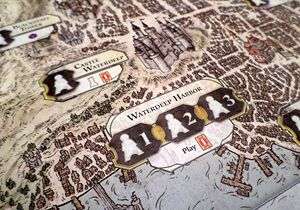 Other than the obvious, Dungeons & Dragons is often associated with a load of 20 sided dice, character sheets, complicated rules, rubbish hand-drawn maps, and people with a lot of time on their hands shouting ‘Huzzah’ every fifteen minutes. So when I first heard about Lords of Waterdeep, a game with a D&D theme, I wasn’t sure I was going to like it, as the only role playing I tend to do involves me dressing up as a burglar and breaking and entering your Mum’s knickers. In this worker-placement game published by Wizards of the Coast, 2 -5 players take on the roles of shady masked Lords vying for control of the City of Waterdeep by sending adventurers out on dangerous quests to score victory points.
Other than the obvious, Dungeons & Dragons is often associated with a load of 20 sided dice, character sheets, complicated rules, rubbish hand-drawn maps, and people with a lot of time on their hands shouting ‘Huzzah’ every fifteen minutes. So when I first heard about Lords of Waterdeep, a game with a D&D theme, I wasn’t sure I was going to like it, as the only role playing I tend to do involves me dressing up as a burglar and breaking and entering your Mum’s knickers. In this worker-placement game published by Wizards of the Coast, 2 -5 players take on the roles of shady masked Lords vying for control of the City of Waterdeep by sending adventurers out on dangerous quests to score victory points.
Thematically speaking, the game sounds typically exciting if you’re a bit of a D&D buff, however with LoW, the theme is just that, a theme. It could be set in any other universe you wanted and it wouldn’t make a difference to the game itself or how you played it. To some that might sound like a bad thing, but don’t let that put you off; peel back the theme and there is a brilliant game underneath that is well worth your time.
Players start the game by randomly selecting a Lord of Waterdeep card. This card is kept secret until the end of the game and provides you with the identity of your Lord, and will task you with completing certain types of quests in order to earn bonus points at the end of the game. There are five types of quests: Commerce, Warfare, Skullduggery, Piety and Arcana, each of which require different types of resources to complete. For example, Warfare quests mainly require Fighters to be completed, while Piety require more Clerics, and so on. The Lord card you select will generally ask you to complete two types of quests in exchange for bonus points, with the exception being one of the Lords who asks you to construct buildings instead. It’s up to other players to keep an eye on what type of quests you are picking up and try to stop you from completing them. At the end of the game the Lords are revealed and bonus points are added onto the victory points earned from completing quests.
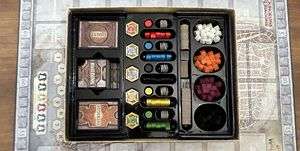 Once Lords are selected, a first player is decided upon, initial quest cards are handed out, and the appropriate amount of gold is given to each player depending on their starting position, and then the game can begin. Players gather resources via their Agents, who are represented by wooden meeples matching the player colours. The number of Agents you have is determined by the number of players in the game – the more players, the fewer Agents on the board and therefore the harder it is to gain resources.
Once Lords are selected, a first player is decided upon, initial quest cards are handed out, and the appropriate amount of gold is given to each player depending on their starting position, and then the game can begin. Players gather resources via their Agents, who are represented by wooden meeples matching the player colours. The number of Agents you have is determined by the number of players in the game – the more players, the fewer Agents on the board and therefore the harder it is to gain resources.
Players then take it in turns to put an agent onto the various buildings on the board, which give resources or other things in return. To begin with there are nine default buildings on the board, one for each of the five resources: Gold, Fighters, Clerics, Wizards and Rogues, another building for gaining new quests, one for stealing the first player token, one for playing special Intrigue cards, and, finally, one for constructing new buildings. Generally speaking, only one Agent can occupy a building at a time, with a few exceptions such as the buildings which allow you to pick up quests and play an Intrigue card, both of which can support up to three Agents. The single Agent restriction can sometimes make it difficult to collect particular resources as it’s first come first served; this is made worse if you are last to go on that particular turn. As such, it’s important to steal the first player token by occupying the Castle Waterdeep space, even if it means not getting any other resources with that Agent.
The default buildings give the minimum amount of resources for each thing so it’s advantageous to construct new and more powerful buildings (which show up in the Builder’s Hall space), even if it means wasting one of your Agent’s moves to do this. For example, the default building for Fighters is The Field of Triumph – this gives you two Fighters when placing your Agent on it. Alternatively, you could purchase a building called the Smuggler’s Dock which means, in return for two gold pieces, you could take any combination of four Fighters or Rogues. Much better! This of course all depends on whether that building comes up to be built. As there are only three buildings available in the Builder’s Hall at any one time you never quite know what is going to turn up. New buildings from the stack replace those that are built, and with twenty three buildings in the base game each game can be quite different from the last. Games have been lost because I’ve not been able to get enough Wizards or Fighters in order to complete my quests, while in other games it’s been down to another resource I’ve been desperate for. There will be occasions where buildings that you don’t particularly need come up for sale in the Builder’s Hall. The game incentivises the purchase of these building by adding a victory point to each building in the Builder’s Hall at the start of the round. The points are stacked on top of the game round tracker so that when the points are added to the building it reveals the round number you are on, therefore acting as a clever way to track how many rounds are left.
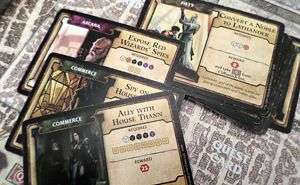 Even after you’ve built something, there’s no guarantee you’ll even get to use it that round, as other players can get there before you. Fortunately, buildings always have an owner reward, which the owner will receive when someone else uses their building. This can be in the form of resources, intrigue cards or even victory points. As such it’s always worth building if you’ve got the gold to spare and you have the opportunity. If you’re still finding it difficult to pick up resources you can also try and get an Agent on the Castle Waterdeep space, which gives you the power to go first on the next turn and therefore get first choice of the buildings.
Even after you’ve built something, there’s no guarantee you’ll even get to use it that round, as other players can get there before you. Fortunately, buildings always have an owner reward, which the owner will receive when someone else uses their building. This can be in the form of resources, intrigue cards or even victory points. As such it’s always worth building if you’ve got the gold to spare and you have the opportunity. If you’re still finding it difficult to pick up resources you can also try and get an Agent on the Castle Waterdeep space, which gives you the power to go first on the next turn and therefore get first choice of the buildings.
As quest cards are laid on the table face up, all players know what resources you require and an element of tactics come into play, as players attempt to block each other from gathering certain resources. The bastards. Once the requisite amount of resources have been gathered, quests can be turned in and the quest reward printed on the card can be collected. This is normally victory points but some quests offer other resources, Intrigue cards and sometimes more quests or free buildings. You can have as many quests as you like, and with no penalty for not completing quests it’s a valid tactic to pick them up just to stop others from taking them. Another note about quests: some of them are known as Plot Quests. These are special in that they often provide an effect for the rest of the game once they have been completed. For example, the Quell Mercenary Uprising plot quest will give you an additional two points every time you complete another Warfare quest, while the Infiltrate Builder’s Hall plot quest will give you four points every time you construct a new building. Completing the right plot quests can be key to success in this game as they provide that little extra advantage. However, I do think that some of them are a bit too powerful in certain situations. The Bolster Griffin Cavalry quest gives an additional Fighter on top of any other Fighters you collect during the game. This doesn’t sound particularly powerful on the face of it, but if you manage to complete this early and you need to complete Warfare quests it definitely gives you the upper hand.
I’ve mentioned Intrigue cards a few time now; these are special cards that are kept secret from other players and are designed to either give you a little leg up or give another player a little ‘fuck you’, in exchange for delaying one of your Agents’ turns. For example, to play an Intrigue card you place an Agent on the Waterdeep Harbour space, which has three spaces on it, allowing up to three Agents to play a card during a round. Players can have multiple agents at the Harbour during a round so it’s first come, first served. Once an Agent has been placed, an Intrigue card is played. These have various effects, such as allowing you to take some resources, use a space occupied by another player, or give another player a Mandatory Quest which must be completed before any other quests. These are particularly annoying as they all have a low resource-to-points ratio and force players to waste turns completing them. At the end of the round when all players have played all their Agents, those that have placed an Agent on one of the Waterdeep Harbour spaces get to play those Agents again and place them on the remaining unoccupied spaces, effectively giving you another turn with those agents. Good use of Intrigue cards can turn a game around for players who have found themselves falling behind everyone else.
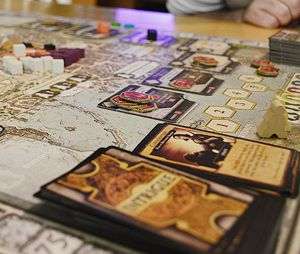 After everyone has used all their Agents the round ends and everyone takes back their Agents to start a new round. With only eight rounds to play the game doesn’t drag on too long, and I’ve found that a five player game can be done in just over an hour. If you’re playing with new players it may take a little longer as it generally takes a few rounds to “get” what is going on, but you’ll certainly be done in an hour and a half. My wife and I can manage a game in about half an hour. At the end of the game, any unspent resources are first totaled up and converted to points. You will get one point per adventurer and one point for every two pieces of gold you have. Lords are then revealed and bonus points are given out. Players will get four points for every quest matching their Lord card and the builder will get six points for every building they’ve completed.
After everyone has used all their Agents the round ends and everyone takes back their Agents to start a new round. With only eight rounds to play the game doesn’t drag on too long, and I’ve found that a five player game can be done in just over an hour. If you’re playing with new players it may take a little longer as it generally takes a few rounds to “get” what is going on, but you’ll certainly be done in an hour and a half. My wife and I can manage a game in about half an hour. At the end of the game, any unspent resources are first totaled up and converted to points. You will get one point per adventurer and one point for every two pieces of gold you have. Lords are then revealed and bonus points are given out. Players will get four points for every quest matching their Lord card and the builder will get six points for every building they’ve completed.
In terms of components, Lords of Waterdeep is fantastic. The Agents and player score markers are made of wood, and the quest and intrigue cards are a nice grade of card, each with its own unique artwork and flavour text or instructions. Players also get a player mat to organise all their different resources, quests and Agents on, which is actually quite handy. The building cards are made from very solid card too, each with simple-to-understand representations of what rewards they give to the user and owner. The board itself is also superb, providing ample space for all the bits of information that need to be shown, while at the same time acting as more a map of Waterdeep than a playing surface. Overall, I absolutely love the components in this game – even the instruction booklet is excellently presented and full of the game’s great artwork. It’s safe for me to say that Lords of Waterdeep has the best set of components I’ve ever had the pleasure of using in a game. The best thing about the components, however, is actually the box insert you put them all in; every token, every gold piece, every cube, and every card has its own place. When they’ve all gone in, the game board fits into the recess on top of everything and holds it all in place. It’s the organisational equivalent of perfection.
When it comes to the gameplay, the pacing of the game is great. It’s not so long and complicated as to put people off, but not too short as to make it unsatisfying to play. The randomness of which Lord you’re going to get, along with the unpredictable nature of the buildings and quests that come up for selection make for plenty of replayability without the same tactic working every time. You can choose to pay attention to or ignore the other players as much or as little as you want. Do you keep to yourself and concentrate on your own quests, or do you actively set out to screw over your opponents? Either option is a viable tactic, with no one method of playing being particularly advantageous.
This is by far the most played game in my house at the moment. My wife absolutely loves it, too, and in the three or so months we’ve owned it we’ve played it almost every day. Speaking of buying it, let’s talk price. This game RRPs at £39.99, however there are deals to be had online and it is available for much cheaper. Saying that, I paid the full price for it and I’d do it again given the amount of entertainment I’ve had out of it. Well worth the asking price.
Pros- Fantastic replayability
- Brilliant components
- Easy to learn and to teach
- The apex of the Work Placement genre
- The best box insert ever
- Some quests aren’t quite balanced
- The odd plot quest is overpowered
- Erm, that’s probably it
Despite the tacked on D&D theme, Lords of Waterdeep is a brilliant game and, by far, one of my favourite games from the Worker Placement genre. The level of replayability is surprising, with no two games I’ve played so far being exactly the same. There is a slight tactical element, but it’s nothing too heavy. If I were to recommend one board game to buy this year then it would be Lords of Waterdeep, I really can’t praise it enough - from the artwork to the components, the game is nearly perfect. The only single downside I can possibly think of is that some of the quests aren’t quite balanced in terms of the resources required to complete and the reward given in return, especially when other quests offer far more as rewards for the same effort, and some of the plot quests are very powerful. However, that’s a minor quibble in the grand scheme of things and isn’t a reason for not playing
Last five articles by Ste
- Acoustic Gaming: X-Wing Miniatures Game - Review
- Acoustic Gaming: Pandemic Legacy – Season One
- Bored Gaming
- U Wot Mate?
- Tabletop Simulator - Review














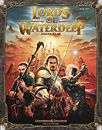


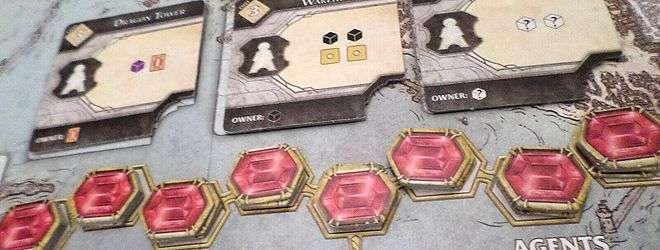
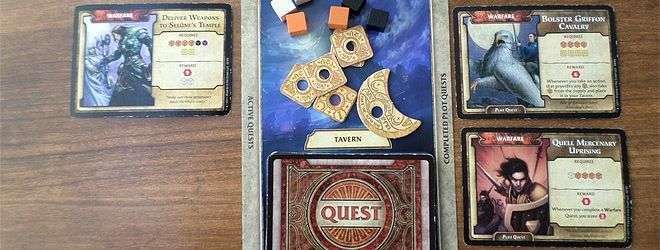
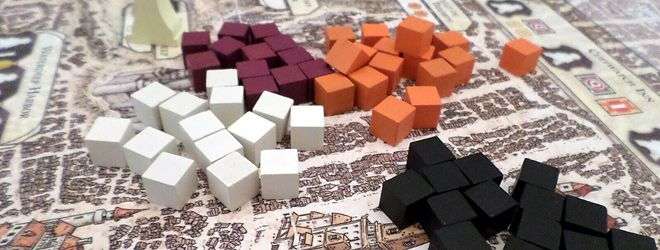
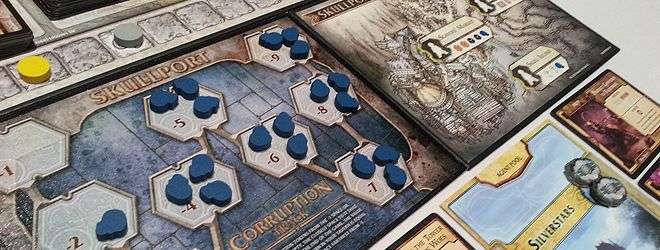






There are no comments, yet.
Why don’t you be the first? Come on, you know you want to!